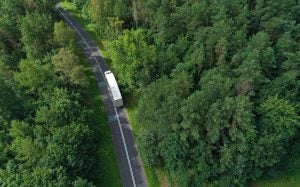This blog post was authored by Pedro Piris-Cabezas, Director of Sustainable International Transport & Lead Senior Economist at Environmental Defense Fund

As the world convened for COP 26, the United Nation’s civil aviation body announced a major milestone in the transition to sustainable flight by adopting an expanded set of sustainability criteria for sustainable aviation fuel (SAF), available here.
SAF — jet fuel made from renewable feedstock instead of fossil fuels — provides a distinct opportunity to put aviation on a pathway to net-zero climate impact by 2050. But, to achieve that level of success, the SAF that airlines will use to be eligible for ICAO’s emissions reduction program, the Carbon Offsetting and Reduction Scheme for International Aviation (CORSIA), must meet a high standard of environmental integrity, and be accurately tracked and accounted for. Indeed, not all alternative fuels are equal. Some make environmental problems worse. Deploying SAF without a robust accounting and sustainability framework could negate the entire climate benefits and even increase emissions several-fold compared to fossil jet fuels.
After years of hesitation, ICAO Council Members finally seized the opportunity to set these forward-looking sustainability safeguards, ensuring that SAF eligible under CORSIA lives up to its sustainability potential, and provides certainty for SAF producers as they make investments in the sustainability of their supply chains and operations.
Not only is this decision a major milestone for ICAO, it is also the first time a UN body has defined a clear standard for what constitutes sustainability for a mitigation action. ICAO has also operationalized it with a full-fledged monitoring, reporting and third-party verification system including a high level of assurance, which makes CORSIA the most comprehensive SAF Framework adopted to date.
ICAO’s decision also sends a clear signal to countries embarking in SAF policy: support for SAF must include robust environmental safeguards. This is critical because ICAO’s SAF framework can enable the production of truly climate beneficial SAF but only if paired with effective national policies that generate the needed economic incentives.
The Council’s adoption of the SAF sustainability criteria is a turning point in the aviation sector’s journey to decarbonize—but it is far from its final destination. Now, countries, airlines, and fuel producers must take action to jump-start high-integrity SAF by shaping their national SAF policies accordingly.
EDF, as a member of the International Coalition for Sustainable Aviation (ICSA), the group of environmental NGOs with observer status at ICAO, took a leadership role in this important development. EDF created the space for this negotiation to take place in ICAO’s Committee for Aviation Environmental Protection and was granted the privilege to co-chair the technical negotiations on SAF sustainability matters together with the International Air Transport Association (IATA). This privileged position gave us the capacity to thoughtfully design the negotiations and create the necessary coalitions to ensure, against all odds, the sequential adoption of the sustainability criteria and framework along ICAO’s political decision-making process.
What’s the role of the SAF sustainability criteria?
The role of sustainability criteria is to safeguard against direct and indirect negative effects on ecosystems and communities that are not captured or are underestimated by the lifecycle assessment approach, and to promote sustainable development.
To be eligible under ICAO’s CORSIA, SAF needs to meet the following overarching goals across its supply chain:
- Reduce greenhouse gas emissions compared to fossil jet fuel on a lifecycle basis. The criteria ensures that SAF provides meaningful emissions reductions, counted across the full lifecycle of the fuel from feedstock to flight, and including key indirect environmental effects such as indirect land use change. The 10% minimum emissions reduction required by ICAO might appear disappointing at first sight, but it should be noted that –in its current shape— it is only intended as a safeguard to ensure that any emission reduction claim in CORSIA is backed up with real emissions reductions that go beyond the uncertainties associated to the lifecycle assessment methodology. Independently, only SAF that delivers large emissions reductions makes sense economically and environmentally speaking, which means that SAF with large land use change emissions is tacitly disqualified as a viable production pathway. That’s the magic of assessing SAF on a lifecycle basis including indirect land use change emissions.
- Protect ecosystems and natural resources. The robust set of sustainability criteria also includes environmental safeguards against negative environmental effects that are not captured by the lifecycle emissions assessment—defending water quality, soil health, air quality, biodiversity and conservation values.
- Present no risks to human rights, food security, or local economies. Ensuring that SAF feedstock production does not present social risks, ICAO prioritized the inclusion of human and labor rights, land use rights and water use rights for local and indigenous communities.
- Promote the achievement of the UN Sustainable Development Goals. As a United Nations body, the ICAO championed these sustainability criteria aiming for SAF to contribute to the achievement of UN Sustainable Development Goals (SDGs), including eliminating poverty and promoting food security.
What’s in the SAF sustainability criteria?
The criteria cover 12 themes that encompass the three pillars of sustainability: social, environmental, economic. Provisions pertain to emissions reductions, carbon hotspots, water, soil, air, conservation, waste and chemicals, human and labor rights, land use rights and land use, water use rights, local and social development, and food security. For each theme, a principle a set of criteria are outlined. The criteria capture the binding provisions.
To be eligible under ICAO’s CORSIA to generate emissions reductions for compliance purposes, SAF must meet the following criteria:
| Theme | Principle | Criteria |
| 1. Greenhouse Gases (GHG) | Principle: CORSIA SAF should generate lower carbon emissions on a life cycle basis. | Criterion 1.1: CORSIA SAF will achieve net greenhouse gas emissions reductions of at least 10% compared to the baseline life cycle emissions values for aviation fuel on a life cycle basis. |
| 2. Carbon stock | Principle: CORSIA SAF should not be made from biomass obtained from land with high carbon stock. | Criterion 2.1: CORSIA SAF will not be made from biomass obtained from land converted after 1 January 2008 that was primary forests, wetlands, or peat lands and/or contributors to degradation of the carbon stock in primary forests, wetlands, or peat lands as these lands all have high carbon stocks. |
| Criterion 2.2: In the event of land use conversion after 1 January 2008, as defined based on the Intergovernmental Panel on Climate Change (IPCC) land categories, direct land use charge (DLUC) emissions will be calculated. If DLUC greenhouse gas emissions exceed the default induced land use change (ILUC) value, the DLUC value will replace the default ILUC value. |
| 3. Water | Principle: Production of CORSIA SAF should maintain or enhance water quality and availability. | Criterion 3.1: Operational practices will be implemented to maintain or enhance water quality. |
| Criterion 3.2: Operational practices will be implemented to use water efficiently and to avoid the depletion of surface or groundwater resources beyond replenishment capacities. |
| 4. Soil | Principle: Production of CORSIA SAF should maintain or enhance soil health. | Criterion 4.1: Agricultural and forestry best management practices for feedstock production or residue collection will be implemented to maintain or enhance soil health, such as physical, chemical and biological conditions. |
| 5. Air | Principle: Production of CORSIA SAF should minimize negative effects on air quality. | Criterion 5.1: Air pollution emissions will be limited. |
| 6. Conservation | Principle: Production of CORSIA SAF should maintain or enhance biodiversity, conservation value and ecosystem services. | Criterion 6.1: CORSIA SAF will not be made from biomass obtained from areas that, due to their biodiversity, conservation value, or ecosystems services, are protected by the State having jurisdiction over that area, unless evidence is provided that shows the activity does not interfere with the protection purposes. |
| Criterion 6.2: Low invasive-risk feedstock will be selected for cultivation and appropriate controls will be adopted with the intention of preventing the uncontrolled spear of cultivated non-native species and modified microorganisms. |
| Criterion 6.3: Operational practices will be implemented to avoid adverse effects on areas that, due to their biodiversity, conservation value, or ecosystem services, are protected by the State having jurisdiction over that area. |
| 7. Waste and Chemicals | Principle: Production of CORSIA SAF should promote responsible management of waste and use of chemicals. | Criterion 7.1: Operational practices will be implemented to ensure that waste arising from production processes as well as chemicals used are stored, handled and disposed of responsibly. |
| Criterion 7.2: Responsible and science-based operational practices will be implemented to limit or reduce pesticide use. |
| 8. Human and labour rights | Principle: Production of CORSIA SAF should respect human and labour rights. | Criterion 8.1: CORSIA SAF production will respect human and labour rights. |
| 9. Land use rights and land use | Principle: Production of CORSIA SAF should respect land rights and land use rights including indigenous and/or customary rights. | Criterion 9.1: CORSIA SAF production will respect existing land rights and land use rights including indigenous people’s rights, both formal and informal. |
| 10. Water use rights | Principle: Production of CORSIA SAF should respect prior formal or customary water use rights. | Criterion 10.1: CORSIA SAF production will respect the existing water use rights of local and indigenous communities. |
| 11. Local and social development | Principle: Production of CORSIA SAF should contribute to social and economic development in regions of poverty. | Criterion 11.1: CORSIA SAF production will strive to, in regions of poverty, improve the socioeconomic conditions of the communities affected by the operations. |
| 12. Food security | Principle: Production of CORSIA SAF fuel should promote food security in food insecure regions. | Criterion 1: CORSIA SAF production will, in food insecure regions, strive to enhance the local food security of directly affected stakeholders. |
Figure: ICAO Document CORSIA Sustainability Criteria for CORSIA Eligible Fuels. Chapter 2. CORSIA sustainability criteria applicable for batches of CORSIA SAF produced by a certified fuel producer on or after 1 January 2024.
How are SAF sustainability criteria implemented?
The ICAO sustainability framework works as an umbrella standard that relies on ICAO-approved independent Sustainability Certification Schemes (SCS) for its implementation. These organizations define the sustainability certification requirements including the indicators and metrics to evaluate compliance with the criteria, set the requirements for certification bodies, auditors and accreditation bodies, and monitor the effectiveness of the assurance system. To become ICAO-approved SCS must undergo a thorough evaluation process and meet a comprehensive set of requirements in line with ICAO’s eligibility framework.
In conclusion, the newly adopted sustainability criteria take a robust and equitable approach, placing environmental and social safeguards on the production of SAF across its entire supply chain. It also provides a harmonized approach to ensure that airlines across the world strive for these same values of climate ambition, environmental integrity, human rights, and social equity.
This new set of sustainability criteria and the broader sustainability framework are designed to ensure the future of flight allows travelers to see new horizons, connect with other cultures, visit faraway loved ones and collaborate internationally – while doing less harm to our climate, and respecting our environment, and local and indigenous communities. As more countries, airlines, and fuel producers adopt and adhere to this robust criteria, the faster we can reach our destination of a net-zero emissions flight by 2050.














